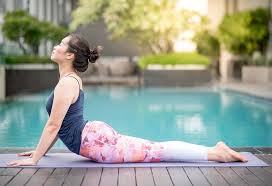The name for this pose “Malasana” comes from two words:
“Mala” — meaning “garland”
“Asana” — meaning “pose”
In yoga, Malasana means a Deep squat. It will open the hips and groin region. It is an excellent pelvic floor exercise. Moreover, you can also call it a grounding asana. The symbolism mainly points towards the cyclic nature of things. It is a great practice for anyone, who wants to utilize one asana to affect many parts of the body.

How To Do It?
⦁ Begin by squatting. While squatting, keep your feet close to each other, with your heels on the floor or supported on the ground.
⦁ You have to separate your thighs, placing them slightly wider than your body width.
⦁ Exhale and then lean forward slightly, so that your torso fits in between your thighs.
⦁ Join your palms in the Anjali Mudra, and press your elbows against the inner thighs. Doing this will also help you extend the front part of your upper body.
⦁ Press the inner part of the thighs against the side of the torso. You can stretch your arms out, and swing them in such a manner, that your shins fit into the armpits.
⦁ Hold the pose for a few seconds. Inhale and release.
Benefits
Malasana is extremely beneficial for all the practitioners. You should read about all the benefits here.
⦁ All those ladies, who suffer from Polycystic Ovary Syndrome, which is caused by hormonal imbalance, will get some respite from their issues. The Malasana or Garland pose also helps in restoring balance to the body.
⦁ If you suffer from constipation, then also you will get relief, if you practice this asana regularly. It helps in the proper elimination of wastes from the body.
⦁ If you have stiffness in the hip area, Malasana practice can alleviate that as well. It will make you more flexible.
⦁ While practicing Malasana, you have to keep your spine erect. So, you are correcting your posture in the process.
⦁ The regular practice of the asana helps in calming down the nervous system. It also improves balance.
⦁ This asana or pose can also alleviate your diabetes issue and cardiovascular issues as well.
⦁ Many women suffer from urine leakage, after delivery or in old age. The regular practice of this asana can help you to overcome that.
⦁ It also increases blood flow in the pelvic region.
⦁ It gives a deep stretch to the abdominal region.
⦁ It also gives the ankles a good stretch.
Contraindications
⦁ You should not practice this asana, if you have chronic back pain or knee pain.
⦁ If you have any medical condition in your spine, legs, or hips, you should not practice this asana.
⦁ If you had a recent accident, you must not practice this asana.
Our courses :- 100 hour yoga teacher training in rishikesh , 200 hour yoga teacher training in rishikesh , yoga retreat in rishikesh





